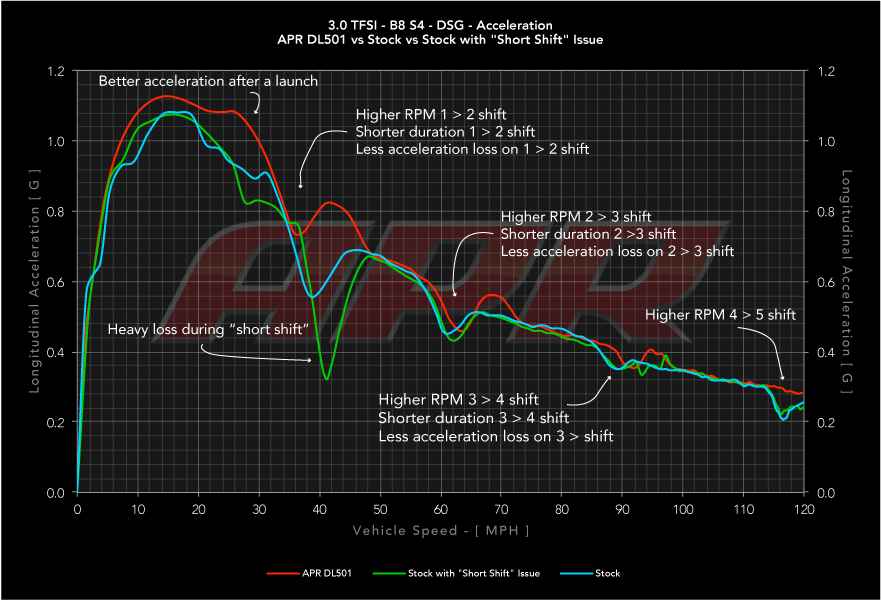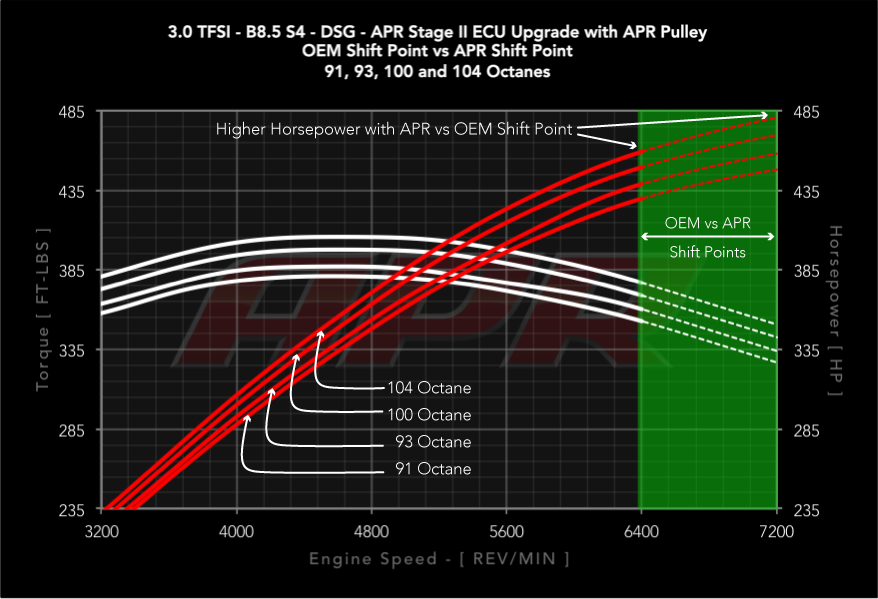APR TCU Upgrade
APR’s TCU upgrade goes beyond the overly simplistic norm of raising a few limiters, and offers a wide gamut of changes designed to completely enhance the driving experience. With an in-depth knowledge of the transmission’s inner workings and control strategies, APR’s engineers have improved many aspects of the transmission from accelerative performance to daily drivability, while also incorporating new features including several typically reserved for higher-end Audi Quattro GmbH RS models.
Depending on the driving scenario, APR’s calibration experts have created multiple operating modes designed to deliver ideal performance for the given driving condition. When using launch control, the transmission enters a maximum acceleration mode designed to provide the fastest possible acceleration through a heightened application of torque, optimized shift points and shift strategies among other performance related enhancements. Under blistering, near wide-open throttle, the transmission enters a different state of performance with shift maps optimized for power delivery on vehicles with modified engine software. Manual and Tiptronic mode are tailored to the driver’s desired auto up/down shift preferences at the time of install include several features to enable quicker paddle response times and faster upshifts on Gen 2/B8.5 models. Finally under part-throttle daily-driving in both Drive and Sport mode, the transmission remains calm and smooth. Common clunks and driver annoyances are addressed and the transmission comfortably responds to the driver’s input without constantly and aggressively seeking the highest gear possible.
Feature List
- 7,200 max shift point with gear dependent overshoot protection.
- User adjustable 3-Step multiple launch control RPM.
- User definable* max launch control RPM up to 6,000 RPM.
- User definable* manual mode downshifts (on/off).
- User definable* manual mode upshifts (on/off).
- Launch control enabled on all models.
- Launch control response enhanced for quicker launches.
- Launch control limits raised from 200 to 3000 launches.
- Launch control Max acceleration mode enabled for the fastest possible acceleration.
- Multiple acceleration modes defined for various driving scenarios.
- Manual mode / TT mode paddle response time optimized.
- Manual mode / TT mode shift optimized with gear dependent thresholds on Gen 2/B8.5 Models.
- Torque intervention limits raised, while retaining temperature protection.
- Temperature management modified.
- Transmission coolant pump optimized during high temp scenarios.
- Gear display enabled in Drive and Sport.
- Optimized Drive and Sport mode shift maps.
- Downshift "lockout" disabled below previous gear's max RPM.
- First gear, rolling-stop, "clunk" addressed.
- First gear "short shift" addressed.
- Significant power increase on applications meeting peak power well above the vehicle’s factory defined shift points.
*APR’s DirectPort Programming suite allows the end user to tailor the TCU upgrade to their needs at the time of installation.
Drive (eco) and Sport Mode


APR’s engineers have paid close attention to the factory shift maps in drive (eco) and sport mode to help ensure a more pleasurable driving experience. In each mode under high-torque and high-rpm situations, the shift points are increased progressively just below the transmissions new maximum shift point of 7,200 RPM. Gear dependent overshoot protection prevents the transmission from hitting the rev limiter prematurely. Finally using launch control enables the maximum acceleration mode while in Sport.
Under low-torque, low-rpm part-throttle situations, both drive mode and sport mode behave similar to stock. The shift points are raised to prevent the transmission from over aggressively seeking seventh gear prematurely in drive mode and to provide a more sporty feeling in sport mode. The first to second gear short shift has been addressed and while rolling to a stop, the transmission will no longer prematurely downshift to first gear, resulting in a clunky transition.
Manual and Tiptronic Modes

APR’s user definable options allow the end user to configure how manual mode operates. The kick-down switch, which is responsible for an automatic downshift in manual mode, is enabled by default but can be disabled at the time of install. Likewise, the auto upshift that occurs near the new 7,200 RPM redline can also be disabled if the end user chooses, allowing the engine to bounce off the limiter like a manual transmission. For safety's sake, the first to second auto upshift is always enabled. The transmission does not lock out any manual downshifts so long as the shifting does not result in an engine RPM above the max shift point. In all situations, paddle delay is greatly reduced allowing for more responsive shifts to take place. On Gen 2/B8.5 models, using the paddles and shifter, above gear dependent comfort thresholds near 3000 RPM, will result in lightning fast gear changes as the transmission enters a new "quick shift" upshift mode.
Max Shift Points | | Drive | Sport | Manual
With Auto Upshift Enabled | Manual
With Auto Upshift Disabled |
|---|
|
| First to Second Gear | 6,900 RPM | 6,900 RPM | 6,900 RPM | Never |
| Second to Third Gear | 7,150 RPM | 7,150 RPM | 7,150 RPM | Never |
| Third to Fourth Gear | 7,150 RPM | 7,150 RPM | 7,150 RPM | Never |
| Fourth to Fifth Gear | 7,175 RPM | 7,175 RPM | 7,175 RPM | Never |
| Fifth to Sixth Gear | 7,200 RPM | 7,200 RPM | 7,200 RPM | Never |
| Sixth to Seventh Gear | 7,200 RPM | 7,200 RPM | 7,200 RPM | Never |
Launch Control

APR’s 3-Step launch control is unlike anything else in the market. At the time of flashing, the user chooses a maximum launching RPM up to 6,000 RPM. When activating launch control, up to three launching RPM’s are available, allowing the end user to choose the best launching RPM based on the current conditions!
At 100% throttle with the kick-down switch engaged, the vehicle will select the highest launching RPM. At 100% throttle with the kick-down switch not engaged, a lower launching RPM is activated. Finally, at roughly 50% throttle the transmission chooses the lowest launching RPM. When properly dialed in, the user is left with incrementally higher launch points ideal for the street, track and sticky tires.
Adjustable Launch RPM Profiles | Max | Mid | Min |
|---|
|
| 6,000 RPM | 5,000 RPM | 4,000 RPM |
| 5,500 RPM | 4,500 RPM | 3,500 RPM |
| 5,000 RPM | 4,000 RPM | 3,000 RPM |
| 4,500 RPM | 3,750 RPM | 3,000 RPM |
| 4,000 RPM | 3,500 RPM | 3,000 RPM |
| 3,500 RPM | 3,250 RPM | 3,000 RPM |
| 3,000 RPM | 3,000 RPM | 3,000 RPM |
S Tronic Temperature Management

Temperature management is an important part of the DL501 transmission. While some may simply remove temperature protection routines all together, or mistakenly raise temperature protection torque limiters sky high and claim increased cooling performance due to zero transmission intervention, APR’s TCU upgrade only allows the maximum safe temperature levels before intervention. Under high stress scenarios, such as launch control, the transmission’s cooling pump runs at maximum speed until the desired transmission temperature is achieved.
Unlike the factory intervention routine, which allows for nearly no torque to be transmitted through the transmission at all after limits are crossed, APR’s over temp intervention allows for a limited amount of torque, enough so the vehicle can be safely driven off the track or pulled to the side of the road during intervention. In keeping the vehicle moving, airflow continues across the radiators, which in turn keeps coolant temps low and aids in removing heat from the factory DL501 oil coolers to restore full operation.
Torque Limits

Various factory torque intervention limiters are raised to their maximum value to eliminate unintended torque intervention, across the rev range, during normal and spirited driving. However, important and critical limiters are kept in place or only slightly modified, such as those related to temperature protection, to prevent premature damage to the transmission in dangerous scenarios.
Gear Display Indicator

In drive (eco) and sport mode, the vehicle’s multi function display will now indicate the currently selected gear rather than a generic D or S.
Utilization of launch control results in the transmission entering the maximum acceleration mode. During this mode, intervention between a shift is minimized, resulting in faster acceleration that keeps the driver planted to the back of his or her seat. Furthermore, the transmission’s coolant pump is fully optimized to keep oil temperature within the desired operating temperature.
Launch control is activated on all models, including those without it from the factory. The conditions necessary to enable launch control have been tweaked to make activation easier and the delay typically present after lifting the brake and beginning of the physical launch has been greatly reduced. Lastly the factory 200 launch limit has been raised 1400% to 3000 launches!
Recommendation: When using launch control, excessive wheel spin will not improve acceleration and may cause undesirable behavior. APR suggests using lower launch limits near 4,000 RPM under low grip situations. Maximum launch RPM is only ideal with drag slicks / radials on a well-prepped drag strip.
Note: Both ASR and ESP must be fully off and the vehicle in Sport Mode to use Launch Control. This is accomplished by holding the traction control button for a length of time.
Acceleration Improvements

APR’s engineers were able to improve vehicle acceleration through enhancements such as better launch control, higher shift points, and measurable reductions in shift duration and shift intervention as illustrated above.
The graph above shows longitudinal acceleration G-Forces, and the below graph shows vehicle speed over time on an APR Stage II B8 S4 with race fuel. APR’s TCU upgrade provided stronger acceleration after the launch which carries to a higher redline shift point. During the shift, very little intervention took place, keeping G’s high and the driver planted in the seat during the quicker shift. Stock, however, suffered more losses, longer shift durations, and even more extreme losses and durations during the common “short shift” issue. Vehicle speed was greatly affected as is evident by the noticeable deviation in acceleration at 40 MPH on the graph below.
The APR TCU equipped vehicle continued to gain in speed over the stock setup thanks to higher shift points, quicker shifts, and less torque intervention as illustrated in the graphs. 0-120 MPH was reduced by .75 second over the stock TCU and .97 seconds over the stock TCU exhibiting the “short shift” issue!
Increased Power

On some models, the transmission's maximum RPM is set to as low as 6,400 RPM, which is well below the max engine speed as defined by the ECU upgrade. In doing so the engine is unable to produce peak power, as it typically occurs at the engine’s max RPM. Through increasing the max shift point, peak power grows further and results in an additional 20-30 horsepower depending on model, stage and octane.
Application Guides
For use with APR’s ECU upgrades, the latest version is REQUIRED. This update MUST be checked and installed at the time of install. For best results, APR advises against mixing non-APR ECU and TCU Upgrades. APR cannot guarantee full compatibility with non-APR ECU Upgrades as outlined above and as such offers a 30-day money back guarantee as outlined below.
Application Guide | Make | Model | Engine | Transmission |
|---|
| Audi | A4 / S4 (B8 / B8.5) | 3.0 TFSI | 7 Speed S Tronic - DL501 Gen 1, Gen 1.5 & Gen 2 |
| Audi | A4 / S5 (B8 / B8.5) | 3.0 TFSI | 7 Speed S Tronic - DL501 Gen 1, Gen 1.5 & Gen 2 |
| Audi | A6 (C7 / C7.5) | 3.0 TFSI | 7 Speed S Tronic - DL501 Gen 1, Gen 1.5 & Gen 2 |
| Audi | A7 (C7 / C7.5) | 3.0 TFSI | 7 Speed S Tronic - DL501 Gen 1, Gen 1.5 & Gen 2 |
- Please note vehicle manufacturers issue many TCU part numbers and revisions throughout their vehicle lineup. As such, some TCUs may be temporarily unavailable as new parts and/or revisions are released. If the vehicle's TCU part number and revision is known, availability can be checked at any APR Dealer.- *For use with APR’s ECU upgrades, the latest version is REQUIRED. This update MUST be checked and installed at the time of install. For best results, APR advises against mixing non-APR ECU and TCU Upgrades. APR cannot guarantee full compatibility with non-APR ECU Upgrades as outlined above.

















